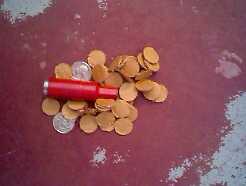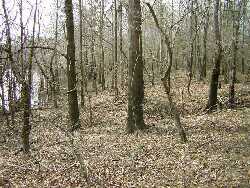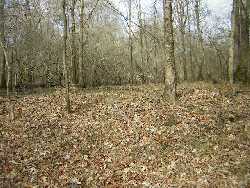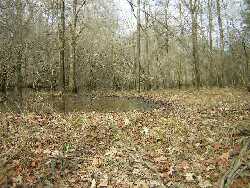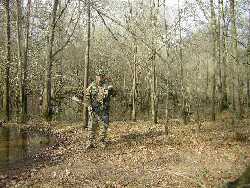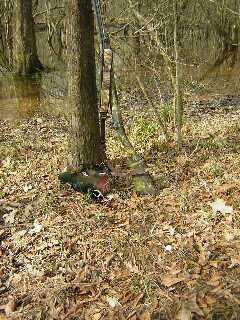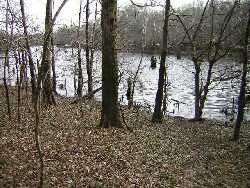Copyright 2005 by Junior Doughty
Click thumbnails for full size photos
 Not long after the muzzleloader bug bit me, I started itching for a shotgun in addition to my pistols and rifles. I would use it with lead shot for wild turkey and with steel shot for ducks. I looked long and hard at the various double-barrel shotguns available, but, in 2002, I finally settled on a single-barrel Thompson-Center Black Mountain Magnum 12 ga with a composite camo stock. The reasons were:
Not long after the muzzleloader bug bit me, I started itching for a shotgun in addition to my pistols and rifles. I would use it with lead shot for wild turkey and with steel shot for ducks. I looked long and hard at the various double-barrel shotguns available, but, in 2002, I finally settled on a single-barrel Thompson-Center Black Mountain Magnum 12 ga with a composite camo stock. The reasons were:
When the shotgun arrived, only one choke tube came with it—a stainless steel Extra Full installed in the barrel. That was perfect for turkeys with lead shot, but the instructions clearly stated to use only Cylinder, Improved Cylinder, or Modified chokes with steel shot. Lucky for me, my junk box contained an old Mossberg 500 Improved Cylinder choke, and it fit perfectly. So I was set for ducks when the time came and with no extra money spent. After perusing the T-C Owner's Manual, which contained lots of lead and steel shot data, and buying and perusing the Lyman BLACK POWDER HANDBOOK & LOADING MANUAL, 2nd edition, I began shooting my new muzzleloader shotgun. I used Pyrodex RS exclusively. (No sacred black for sale anywhere near me.)
I used the wads dry for over-powder wads and soaked in hog lard for over-shot wads. The lubed over-shot wad greased the bore on its way up the barrel. I glued two dry wads together to make a thicker over-powder wad. The above photo shows the bit and a bunch of free wads. The quarters are for scale. Update 2-15-06: I serrated the edge of the hole saw using a cut off wheel in my Dremel® tool. Now, I chuck the hole saw in my drill press, then press the hole saw down against a beer flat backed by a board. It's about 10X faster than the hammer method.
My loading procedure using lead shot:
Each container holds 90 grs By Volume (BV) of black powder. In other words, I carefully made each container to hold the same amount of powder or shot as held by an adjustable black powder measure set on the 90 grs mark—the space occupied by 90 grs of black powder is the same space occupied by 1 1/4 ozs of lead shot. For muzzleloading shotguns using lead shot, use the same volume of powder as shot. The two clothespins attached to the neck cord hold wads. Clamped in the top clothespin, see a freebie lard lubed over-shot wad. In the bottom clothespin, see a high priced (3¢) plastic wad column, in this case a Remington SP 12 Power Piston 1 1/4 oz. I use it for steel shot because I take no chances with steel shot in my high priced shotgun bore—I don't care what T-C says about the suitability of the bore for steel shot. Notice the recovered wad on the right and shot with steel shot. I could shoot that wad again. Not a single steel shot touched my shotgun's bore.
My loading procedure using steel shot:
The shot put 65 pellets in a 10" circle at 30 yards.
The 35 yard can contains 7 through-and-through holes. So, the shotgun shooting just fine, I used the XF choke and #4 lead shot and turkey hunted a couple of times in the spring of 2002. No luck. In the winter of 2004, using the IC choke and 9, .311" round balls, my cousin deer hunted with the shotgun during muzzleloader season. No luck. Finally, on January 30, 2005, the last day of duck season, I used the IC choke and steel shot and took the shotgun duck hunting. I had not been duck hunting for at least 30 years. First, the rules were too damned complicated, in my opinion. Expect for mallards, wood ducks, and coots, I couldn't tell one species of duck from another species of duck—especially flying. Second, I didn't like having to use steel shot. It was hell on shotgun barrels and even worse on teeth. I could see myself chomping on a tasty morsel of duck and cracking a tooth on a steel shot pellet. But I couldn't let the season pass, especially with a like-new muzzleloading shotgun which so far had killed nothing but paper and beer cans. Besides, a camping trip, Hog Camp 2005, was in the planning stage, and part of the plan included a duck sauce piquant cooked over the campfire. And I knew where there were plenty of ducks—in the oxbow lake beside my campsite and in three smaller sloughs just past my campsite and feeding into the lake. Every previous time I had walked past those small sloughs, a flock of wood ducks or mallards had erupted from at least one of them.
After perhaps 30 minutes of stalking, I reached my campsite without seeing a duck in the lake. In this photo, my vacant campsite is just to the right of the camera. We see the lake down the bank and to the left. Invisible ahead and to the center right about 100 yards away lies the first small slough. At the top of the bank, beavers dammed a little drain and created the small slough. My plan then became: Ease down the bank to the edge of the lake, sneak along it until I reached the point where the small slough drained into it, then ease up the bank until my eyes peered over the top and into the small slough. So I walked down the bank and began a slow and long stalk, almost positive the small slough ahead on my right, and now above me, contained a flock of ducks. The moist dead leaves and twigs near the lake felt like walking on a mattress. Finally, with ever so slow steps and in almost total silence, I reached the drain coming down the bank. I turned, facing the bank now rising ahead of me like the slope of a levee, and I stopped for a long moment, listening. Nothing. Well, it's now or never, I told myself. It's time to ease up the bank and see what's in the slough on the other side.
I waited there behind the tree for perhaps a minute, hoping a duck would swim into view. Nothing. Well, what's plan B, oh great white hunter? I had plenty of time, so I decided to move around to the other side of the tree and just wait for awhile. I could lean my back against the tree and rest while I waited. Besides, my eyes would be higher and I could see more of the slough.
I could see much more of the slough from my new position. But I could still see no ducks. I grew tired of holding the shotgun at the ready, so I lowered it. And I waited and watched. Through the flooded bushes and oak trees I could see maybe a 50 yard X 50 yard area of the slough, which extended about 200 yards straight ahead and out of sight. Acorns were everywhere in and out of the shallow water, making the little slough duck heaven. So where were the ducks? Suddenly, I saw a little flash of red about 40 yards ahead and near the left bank. Then the little flash of red became a wood duck drake, swimming slowly from the left to the right. Then, a hen appeared beside him as if by magic. The pair swam to the middle of the slough and just out of range, which I considered 30 yards with steel shot. As I watched, frozen, they leisurely swam across the slough to near the right edge. Then back to the middle. Like magic again, beyond them materialized another duck, then another, and another, yet another—ducks everywhere and all out of range! I stayed frozen, afraid to raise the shotgun to the ready. Then the original pair swam a little closer . . . closer . . . 30 yards and still heading toward me. They turned, in range and heading to the right and giving me a perfect side view of the drake. I cocked the hammer, the usually almost silent "click" seemingly loud now. My eyes focusing only on the drake, I slowly raised the shotgun, then quickly brought it to my shoulder. At the sudden motion, the slough exploded with ducks. The drake rising, I pulled the trigger and the shotgun went crack-boom and fired. Through the recoil and a huge cloud of smoke I saw a dozen or more ducks flying away. Ahead, the drake lay on the water, his head submerged, his wings slowly flapping like in reflex, gently beating the water. Far to the left, a red fox squirrel jumped on the side of the large oak you can see at the very edge of the photo above. He hung there, his bushy red tail whipping angrily and his face looking at me as if to say to me, Where tha hell did you come from?! As the squirrel jumped to the ground and scampered away, I turned my eyes to the drake, now slowly spinning in the water as his legs moved in the throes of death. Finally, he lay still. I watched him for at least a minute, in awe of the fact that after more than 30 years I had finally killed a duck—and with a muzzloading shotgun.
Here in a photo taken with a timer and with my camera tied around a sapling, you see me holding the shotgun and the duck.
As you can see, a wood duck drake is one of the most beautiful creatures in Nature.
My campsite is maybe 100 yards to the left. In a few weeks, I'll sit around a campfire there while the duck simmers in a cast iron pot over the fire. I'll raise a toast of brandy to his memory, his spirit. Then, I'll consume him a few yards from where he lived and died, completing the Circle of Life, the Circle of Nature. True hunters understand the glory of that. . . . |
